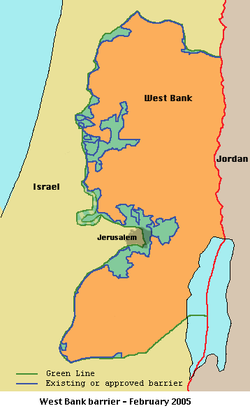Political status of the West Bank and Gaza Strip
|
|
| This article is in need of attention. |
| Please improve (https://academickids.com:443/encyclopedia/index.php?title=Political_status_of_the_West_Bank_and_Gaza_Strip&action=edit) this article. |
The political status of the West Bank and Gaza Strip is one of the most violently disputed issues in the Arab-Israeli conflict. Various conferences and negotiations have been conducted to determine the status of the West Bank and Gaza Strip (see "Palestinian territories").
The Israel-PLO Declaration of Principles on Interim Self-Government Arrangements (the DOP, better known as the Oslo accords), signed in Washington on 13 September 1993, provided for a transitional period not exceeding five years of Palestinian interim self-government in the Gaza Strip and the West Bank. Under the DOP, Israel agreed to transfer certain powers and responsibilities to the Palestinian Authority, which includes the Palestinian Legislative Council elected in January 1996, as part of the interim self-governing arrangements in the West Bank and Gaza Strip.
A transfer of powers and responsibilities for the Gaza Strip and Jericho took place pursuant to the Israel-PLO 4 May 1994 Cairo Agreement on the Gaza Strip and the Jericho Area and in additional areas of the West Bank pursuant to the Israel-PLO 28 September 1995 Interim Agreement, the Israel-PLO 15 January 1997 Protocol Concerning Redeployment in Hebron, the Israel-PLO 23 October 1998 Wye River Memorandum, and the 4 September 1999 Sharm el-Sheikh Agreement.
The DOP provides that Israel will retain responsibility during the transitional period for external security and for internal security and public order of Israeli settlements and citizens. Direct negotiations to determine the permanent status of Gaza and West Bank had begun in September 1999 after a three-year hiatus, but have been derailed by the al-Aqsa Intifada that broke out in September 2000. The resulting widespread violence in the West Bank and Gaza Strip, Israel's military response, and instability within the Palestinian Authority continue to undermine progress toward a permanent agreement.
In 2004, the Israeli government issued a plan for total withdrawal from the Gaza Strip by late 2005, which became known as the Disengagement Plan. The Palestinian Authority welcomed this plan, but declared that until Final Status, the Gaza Strip will still be legally under Israeli occupation. The Disengagement Plan was approved by the Israeli Knesset on February 16, 2005. Implementation is scheduled for summer.

